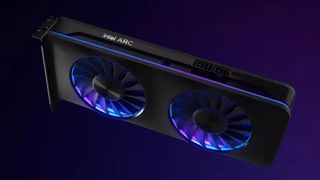Intel moves gaming GPUs and CPUs under same division in latest reorg
Intel CCG will manage all consumer silicon

What you need to know
- Intel's latest reorganization will split up its GPU teams into two, with a focus on gaming and datacenter.
- The company's discrete gaming GPU will fall under the same leadership as its CCG business, which handles processors.
- Its GPU for datacenters will fall under the Data Center and AI business.
- Intel says its teams are "fully engaged" to get the next-gen Intel Arc Battlemage GPU ready, though a definitive timeline was not given.
- Intel's new GPUs not only will face stiff competition from rivals, such as AMD and Nvidia, but Intel is pushing forward with its endeavor at a time when we see a supply glut of graphics cards.
Intel's latest realignment of its business sees the company's graphics division divided into two, with the consumer Arc GPU group managed by the company's Client Computing Group (CCG). This means that consumer graphics led by Intel Graphics Software Engineering Director Lisa Pearce and processors will be managed by CCG head Michelle Johnston Holthaus.
Prior to the reorganization, the graphics division was a separate group under the company's Accelerated Computing Systems and Graphics, or AXG, business, and was led by Executive Vice President Raja Koduri. However, Koduri will return to his previous role as Chief Architect after the change happens.
"With our flagship products now in production, we are evolving our structure to accelerate and scale their impact and drive go-to-market strategies with a unified voice to customers," the company said in a prepared statement, highlighting the importance of the GPU and accelerated computing markets. "This includes our consumer graphics teams joining our client computing group, and our accelerated computing teams joining our datacenter and AI group."
The GPU team responsible for datacenter and GPC products will move to Intel's Data Center and AI (DCAI) business. The teams responsible for the GPU's SoC and IP design will also move to DCAI, the company said, but will continue to support the client graphics team.
For gamers, it's unclear what immediate impacts the reorganization will have on Intel's GPU release timelines, but a closer realignment of its consumer processors and its consumer graphics could help the company find architectural ways to drive better performance gains and drive more tie-ins. Though no longer an exclusive feature to AMD's Radeon and Ryzen families, Intel's rival was able to deliver up to a 15% performance boost when pairing that company's CPU and GPU silicon together through a feature called Smart Access Memory, as an example.
Even though Intel CEO Pat Gelsinger has made bullish comments about the company's endeavor to tackle the discrete GPU market in the past, it's unclear if the company has faced difficulties making inroads in the space. Recent challenges that Intel and its rivals face in the GPU market include a glut of graphics card inventory following years of supply challenges from the global pandemic and prior cryptocurrency demand. There are concerns that if its next-generation discrete gaming graphics cards do not perform well, it may be hard for the company to continue to invest in the business, though Intel has not shown any indication for this.
However, according to a Tom's Hardware report, Intel executives appear to remain committed to the company's existing roadmap of Arc discrete GPUs.
Get the Windows Central Newsletter
All the latest news, reviews, and guides for Windows and Xbox diehards.
This means we could see the second-generation Battlemage and third-generation Celestial gaming cards launching soon. It has been speculated that Battlemage could be released as early as 2023, though Intel refused to give specifics on the timeline given prior delays on the Arc line.
Intel's next-gen graphics will also have the tough job of competing against Nvidia's recently launched RTX 4000 series graphics and AMD's latest Radeon 7900 series.
Outside of the gaming space, Intel's investment in the GPU business will be a valuable asset for the company to tackle the A.I. market. Having a capable GPU, rather than CPU-driven, solution for the datacenter and HPC market will help Intel compete against Nvidia and AMD while delivering higher profit margins.
Chuong's passion for gadgets began with the humble PDA. Since then, he has covered a range of consumer and enterprise devices, raning from smartphones to tablets, laptops to desktops and everything in between for publications like Pocketnow, Digital Trends, Wareable, Paste Magazine, and TechRadar in the past before joining the awesome team at Windows Central. Based in the San Francisco Bay Area, when not working, he likes exploring the diverse and eclectic food scene, taking short jaunts to wine country, soaking in the sun along California's coast, consuming news, and finding new hiking trails.
